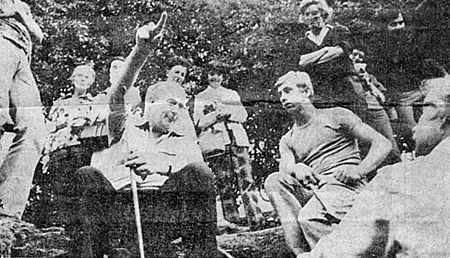|
[Extract from a local newspaper article - no record kept] A school trip - the idea of re-enacting something that happened a century ago is rather appealing, in a romantic sort of way. There is always the possibility that a ghost or two might appear to add a bit of Victorian spirit, or some deep-buried secret reveal itself after decades of obscurity. So it was with the Northamptonshire Natural History Society's visit to Blisworth stone quarry this month. It was planned as part of their current centenary celebrations, since this was the venue of the first trip made by the newly formed Geological Section on August 10, 1876 - being a visit recorded in annals as having a special interest on account of the fascinating variety of fossils found embedded in the limestone, as indicated below. A report in the Natural History Society Journal of that year tells of the "fourteen enthusiastic geologists" who set out on that trip one Thursday afternoon. Their chief finds that day were a set of shark's teeth and the broken tooth of some species of lizard. At that time, of course, the quarry had been worked for some years. Situated in the south-east corner of the parish, it was opened in 1815-1821 and continued until about 1912. A stone-wagon railway connected the quarry to the canal and in so doing crossed the road between Blisworth and Stoke Bruerne. But for this month's trip, the quarry presented a very different picture. It is overgrown with trees and bushes and appears suddenly when you come upon it after tramping across fields of stubble. But for generations of geologists since 1876 it has proved a veritable gold mine, and it inspired many of the local enthusiasts from Campion School to set to work with hammers immediately. The original idea for the centenary jaunt came from the society's section president, Mr. Gordon Osborne, who has been associated with the society over the past 40 years. "It struck me as rather a nice idea, and it seemed to catch on," he said. But, sensibly, Mr. Osborne left the organisation to local historian Mr. George Freeston, a Blisworth-born man, who proved to be a fascinating guide. The visit was conducted in a fleet of cars. After a thorough exploration of the quarry, the group went on to Blisworth Stone Works. Now housing two families, the stone works house was once linked to the quarry by the same railway. It is a splendid monument to a time of thriving industry and plentiful materials for building. In the photo is Mr. Osborne making a point with George Freeston, pictured on the right, ably assisting. In the party from the school, there was at least one, Gary King, who went on to a flourishing career in geology and resources for an oil company - he still has the shark's teeth in a sweets tin. Given time he might have gone on to discover traces of oil beneath Blisworth. In his itinerary sheet Mr. Freeston promised to lay on a full moon "to help the homeward journeys". And, sure enough, there it was, big and golden, shining bright in the dark sky. Which all goes to show what a little organisation will do! |
